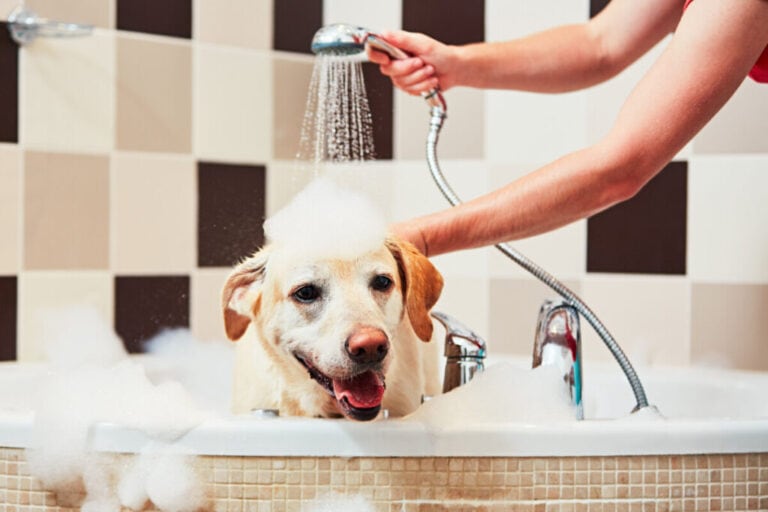Can Labs be Kept Outside?
The Labrador Retriever is like the golden child of the pet kingdom and one of America’s favorite dogs. This breed, created as an energetic and inquisitive fisherman’s companion, is a great addition to any active home. Because these dogs are large, shedding animals that like to be outside, many people wonder if it is okay to keep their Lab outside permanently.
Labradors can be kept outside as long as they have a warm kennel to protect them. However, leaving them outside leaves them vulnerable to poor weather, pests, and separation anxiety. They are happiest when they have people or other animals around them to interact with regularly.
Labrador Retrievers are versatile dogs and can do alright in most environments as long as they are protected from extreme weather conditions and have the company of their “pack,” whether that is humans or other dogs. They can be kept outside as long as certain conditions are met. We will discuss those conditions, and more about Labs, below.
Are Labs Outdoor or Indoor Dogs?
If you’ve ever owned dogs, you may have heard the phrase “indoor dog” and “outdoor dog.” German Shepherds, Labs, and Golden Retrievers are “outdoor” dogs. Chihuahuas, poodles, and other small, high-maintenance dogs are “indoor” dogs…right? Well, that may not necessarily be true. (Source)
Labs are some of the biggest dogs around, and their shedding coats can make them a chore to clean up after and may set off allergies. They also have loud, booming barks. This may make it tempting to keep your Labrador Retriever outside. However, this is ultimately not in their best interest, it may take a toll on their mental and physical health.
While your Lab may tolerate being outside, they will prefer being with their humans over being out in the elements. Labs are extremely social creatures, and they have even more energy than a Golden Retriever.
They like nothing better than to play, chase, and cuddle with their human pack. Left outside, Labs may begin to develop separation anxiety— yes, that’s a real thing for dogs as well. Dogs are naturally pack animals; they find energy in being around others, so throwing them outside while the rest of the pack is in the house may take a toll on them over time.
That being said, if there is a level of outdoor dogs, Labs are up on the scale. Labs can tolerate the outside better than smaller breeds like Shih Tzus or Terriers, which are vulnerable to predators and weather conditions in a way that Labs are not. So, if there is a choice and allergies are not a major concern, try to keep your Lab inside. Ultimately, like all dogs, Labs are indoor dogs.
History of the Labrador Retriever
Labrador Retrievers were originally bred in Newfoundland, Canada in the 1500s. This breed was created to be a fisherman’s assistant: to jump into frigid water to pull in fish and stray fishing nets. Their double-layered, water-repelling coat and webbed paws made them perfect for this task. Even today, Labs typically love the water.
In the 1800s, an Earl brought them home with him to England, where he used them as hunting dogs. This is where they get the name “Labrador,” because they were brought over to Labrador England. In the early 1900s, the Labrador Retriever came to be recognized by the English and American Kennel Clubs, and from there, they became integrated into families around the world.
The history of the Lab is important when considering its needs. This is a dog that was bred to work closely with humans, and it needs socialization on a daily basis. Labs are swimmers and hunters, so they also need daily exercise. This is not a good dog for people who like to live a sedentary lifestyle. (Source)
Effect of Weather Conditions

While Labs have a thick, double-layered coat that has historically protected them from the elements, they can still be affected by excessively cold or hot weather. In reality, your dog can still get sick from being out in the cold wind, rain, or snow, despite their furry coat.
Even in the wild, animals burrow when the weather gets bad. So if you choose to keep your pup outside, be sure to get them adjusted to a nice kennel in which they can protect themselves against the elements. In hotter climates, you must be aware of them as well; your Lab can get heatstroke or heat exhaustion from being exposed to excessively warm temperatures for too long.
Labs Need Exercise
We have mentioned it before and we’ll say it again: Labrador Retrievers need lots of exercise. On average, your Lab will require an hour and a half to two hours of exercise per day to keep them happy and healthy. Many other breeds require as little as thirty minutes of exercise per day, so if you are used to another dog, this might surprise you.
If you have a big yard, your Lab can get some of its energy out running around on its own. However, they will much prefer going for a walk with their human owners, or even a run! The dog park is also an option and is great for your dog to get in that daily exercise while also socializing with other dogs. (Source)
Vulnerabilities of Labs Kept Outside
As we have said earlier, Labs are okay being kept outside, but it is not optimal for their long-term health. One reason for this is because outside, they are more susceptible to fleas and ticks, which naturally attach to warm-blooded creatures that are out in nature. This may take special treatments or even a vet visit to eliminate, which can be expensive for you, the owner.

In addition, your Lab’s mental health has to be taken into account. If your lab is not with its human pack most of the time, it will become lonely and even depressed. This emotional stress can make them less sociable and friendly over time, due to neglect and lack of interaction with humans. If you prefer to have your lab outside, it is best to give them plenty of attention during the day, so they will not feel lonely or neglected.
Weather is also something to consider when deciding if your Lab can handle the outdoors. In temperate climates, this may not be as big of a deal. But in climates with excessive dry heat or snow and ice, your Lab’s health may be at risk and should be taken into account when making your decision.






